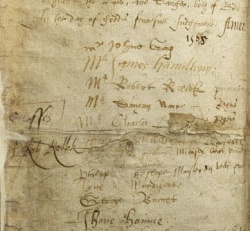Duncan Nairn (d. 1586)

Duncan Nairn (d. 1586) was the second Regent to be employed by Edinburgh University after the the appointment of Robert Rollock (1555-1599) in September 1583 and the opening of the university in October of the same year. Rollock had been appointed as sole regent, but an entrance examination for potential students on 1 October 1583, showed that a substantial number had insufficient Latin to follow Rollock's classes. Rather than dismissing the unsuccessful candidates, Rollock advised that a tutor be employed to drill them in Latin during a preparatory year. The Town Council of Edinburgh turned to Duncan Nairn, who had trained under Andrew Melville at Glasgow University and won first place in the graduation lists of 1580. Nairn was appointed in November 1583. When his class finished their preparatory year, he remained as their regent as they entered the first year of their degree course proper in October 1584. In May 1585, plague broke out in Edinburgh, and classes were suspended until February 1586. In that same month, Nairn died, and Charles Lumsden was appointed as a regent in his place. Duncan Nairn was one of the first signatories, in 1585, of the 'sponsio' or Confession of Faith in Edinburgh University's First Laureation Album, to which all regents and graduates were required to subscribe.
Archives at Edinburgh University
- Signatory of Confession of Faith, 1585, First Laureation & Degrees Album, Edinburgh University Archives (EUA IN1/ADS/STA/1/1)
Sources
- Thomas Craufurd, History of the University of Edinburgh, from 1580 to 1646: To Which is Prefixed the Charter Granted to the College by James VI of Scotland, in 1582 (Edinburgh: Printed by A. Neill & Co., 1808)
- Sir Alexander Grant, The Story of the University of Edinburgh during its First Three Hundred Years, 2 vols (London: Longmans, Green, and Co., 1884)
- James Kirk, ‘Rollock, Robert (1555–1599)’, Oxford Dictionary of National Biography (Oxford: Oxford University Press, 2004 [[1], accessed 8 May 2014]